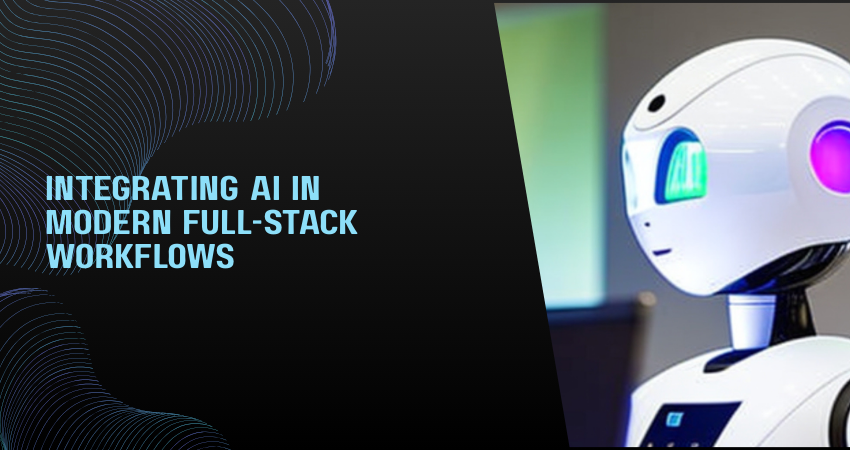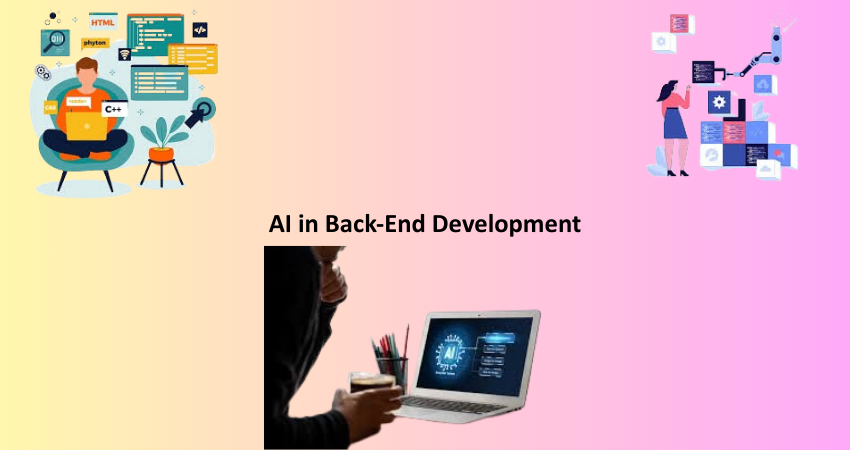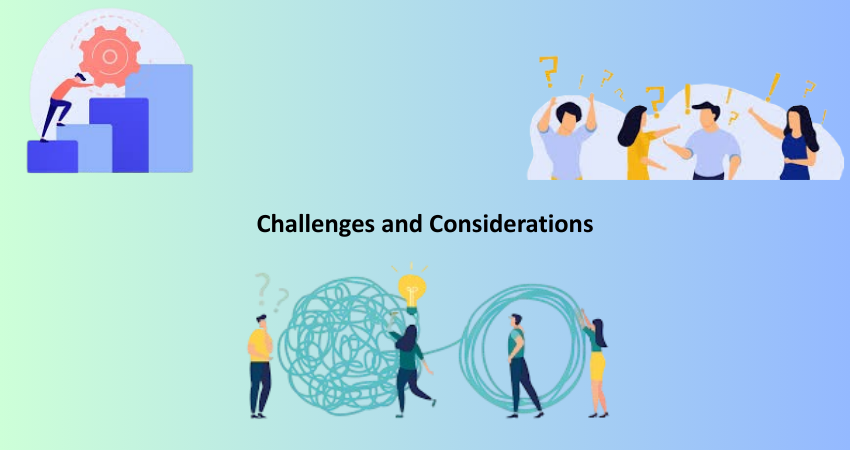
Introduction
Artificial Intelligence (AI) is now no longer a thing of tomorrow, being a present-day technology reshaping the software building and deployment arena. AI is fast becoming a key driver of innovation and efficiency in the modern full-stack workflow cycle, providing its influence at all stages starting from front-end interactions and back-end processes right up to DevOps automation. Traditionally, full-stack development would involve server-sider and client-sider activities, but the ingenious capabilities that come with AI now usher in intelligent tools and frameworks for developers to ensure operational streamlining, enhance user experience, and, ultimately, predict probable issues even before they arise. It has, therefore, brought about a paradigm shift in design, development, testing, and maintenance work by developers.
Full-stack workflows may now be integrated with AI leading to a host of benefits from faster cycles of development to smarter automation and decision-making. AI technologies are making it possible to develop smart and responsive applications that learn and adapt over time, such as front-end features like natural language processing (NLP) and back-end analytics that use machine learning (ML). The third category is the use of AI-driven DevOps tools that detect anomalies in code, optimize performance, and maintain system health with much less manual intervention. Full-stack developers who know how to deploy AI will gain an upper hand in developing robust future-ready applications as businesses move toward the development of software that is even more dynamic and scalable.
AI in Front-End Development
Enhancing User Interfaces with AI
Development of the front end has always focused therefore on its wonderous task that is to deliver seamless user experiences with interactive input; AI has opened new avenues to this objective. The great advantages that can be obtained through the application of artificial intelligence technologies like natural language processing (NLP), computer vision, or sentiment analysis can be realized when the techniques are integrated directly into the front-end to make even more powerful, intuitive, and intelligent interfaces. Like, nowadays it becomes very commonly used at modern websites and apps; these chat-bots are installed through NLP for in-real-time user assistance to answer FAQs and also manage basic tasks without any support from humans. These AI components can be embedded in UI component design through JavaScript libraries or API integrations to ensure adaptive and personalized front-end frames.
Moreover, it is possible for AI to be used for the dynamic adjustment of the user interface (UI) on the basis of user behavior. This includes things like recommending personalized content, self-tailoring layouts according to interaction patterns, and predicting a next likely action by the user so as to reduce friction. AI-based heatmaps and A/B testing tools help designers understand how users deal with their interfaces and hence make better design decisions. With the increasing accessibility of AI tools and integration via APIs and SDKs, full-stack developers continue to be empowered to build highly functional and context-aware engaging front-ends.
Streamlining Front-End Workflows
AI is transforming frontend development by focusing on automation of all the repetitive, boring tasks. Code generation tools like GitHub Copilot or Tabnine assist the developer in code snippets relevant to the given task, correct the syntax errors, and even sometimes suggest or generate an entire function, which again is based on context inputs. The smart recommendations, based on industry standards, will ensure higher code quality and thus lower development time. Besides this, AI-based code generators can quickly fire wireframes or Figma designs into clean HTML/CSS/JavaScript code and hence minimize the turnaround time in the prototyping stage.
Another large benefit AI provides to the frontend workflow is the optimization of performance. Machine learning tools can identify performance bottlenecks, optimize image loading, prioritize critical CSS, and thus greatly enhance loading time and overall user experience. All AI need to do is anticipate compatibility issues in browsers and devices to make sure that developers solve those problems before they arise. By leveraging AI in their toolkit, front-end developers can pay more attention to the strategic task and innovation and not have redundant manual testing and debugging work on their shoulders.
AI in Back-End Development

Intelligent Data Processing and Management
To a large extent, back-end development has always concerned itself with data, while AI has from the beginning gone hand in hand in processing, analyzing, and deriving value from the same set of data. AI-based databases and datapipelines will auto-classify, clean, and structure data to ready it for any downstream applications. Machine-learning algorithms detect patterns, identify anomalies, and generate insights that are utilized in application logic or business decisions. By implementing various AI techniques, ETL processes can be automated, saving time for developers who would require massive amounts of effort otherwise to manage developing systems with huge data volume.
Introduce AI integration so that it may enhance performance optimization and database query processing. AI algorithms often suggest indexing strategies, cache frequently accessed data, find slow queries, and improve the overall responsiveness of the system. The backend frameworks can thereby support this type of AI integration through TensorFlow, PyTorch, and scikit-learn joined to Node.js, Python, or Java-based applications. Startups of any type can be realized with such intelligent backend services: recommendation engine, fraud detection mechanism, or even predictive maintenance function- all powered by AI models created based on historical data.
Automating Business Logic and API Interactions
Up to October 2023, training data was used for this. Backend process enhancement of decision-making automation in APIs can definitely profit from AI. Static business rules can be replaced by or augmented by machine-learning systems capable of identifying trends from historical data. For example, AI systems can provide dynamic pricing, product recommendations, or inventory management based on demand forecasting techniques in e-commerce applications. Thus, at this point, applications are becoming adaptive and are learning from user behavior rather than strictly defined.
Essentially, AI can be used to enhance existing APIs, enabling more robust performance and usage. The natural language interface, which is powered by NLP, shall enable advanced APIs to be easily accessible and, hence, widely accepted. AI-based middleware can also perform API throttling, load balancing, and security checks all autonomously. Leveraging AI to monitor API usage helps developers identify abnormal access patterns, flag potential abuse, or detect inefficient endpoints. All of which makes achieving scalability and security of back-end services a much simpler task. In other words, it has these intelligent AI capabilities that enhance back-end operations that are normally in a static state to become self-optimizing.
AI in DevOps and Continuous Integration
Intelligent Monitoring and Incident Management
AI will also be opening a new horizon in intelligence for systems monitoring and incident handling in DevOps. Traditional monitoring systems primarily depend on fixed rules and thresholds, which gives rise to fatigue in well-placed people and delays in responding. On the contrary, observability platforms powered by artificial intelligence can use machine learning to analyze logs, metrics and traces while running in real time, highlighting anomalies and predicting system failures before they occur. With predictive capability, speedier resolution is possible while minimizing downtime for mission-critical applications.
Artificial intelligence is also upgrading incident response. For instance, Moogsoft, PagerDuty, and BigPanda automate correlation according to alert noise reduction and incident prioritization as impact. AI is capable of triggering automated runbooks and playbooks when certain conditions are met allowing faster remediation. Root cause investigations also involve AI by traversing big datasets in order to find the source of performance impact. Given that intelligent monitoring has already been put into place, DevOps teams can now shift from reactive firefighting to proactive system reliability engineering.
Optimizing CI/CD Pipelines
In a nutshell, the pipelines on which modern software delivery is based are the Continuous Integration and Continuous Deployment (CI/CD) pipelines. The role that AI could take place in such a context is transformative in much such workflows as CI/CD. An AI-augmented tool would be able to predict delivery success as a function of historical build data, code changes, and test patterns. It could also eliminate flaky tests, redundant processes, and unnecessary deployments, so the teams can streamline their deleted lead time: Integrate AI into CI/CD tools such as Jenkins, GitLab CI, or CircleCI in this context as a transformation at these pipelines.
AI would dynamically allocate build and test resources on the fly, thus fetching wait time and cost savings by accurately predicting the number of resources assigned to each build. For example, when fewer resources are needed for a light build, AI detects this and scales up the numbers for a complex regression test. For example, in an environment that is containerized, AI can monitor the health status of a Kubernetes cluster and predictively analyze for automatic scaling or rollback by time. Such automation minimizes the scope for human error, expedites delivery, and ensures the stability and reliability of the releases.
Challenges and Considerations

Data Privacy and Ethical Implications
AI certainly brings in a number of strengths to full-stack workflows but, in doing so, creates some big hurdles; two major ones are data privacy and ethics. The AI systems must be fed with huge datasets for training and continuous learning, while wrong mechanisms and processes of handling such data pose huge damages to compliance and user trust. In this context, it becomes imperative for developers to place their integrations into a legal framework under which the AI technologies must operate: GDPR, CCPA, HIPAA, etc. Such mechanisms will include data security like encryption, user consent flow mechanisms, and a clear-cut data retention policy.
Whether one looks at it through the perspective of transparency or fairness, then it can be said that ethical AI has several different attributes. Algorithms may unintentionally bias on their own if they have been trained using a biased dataset. Thus, it becomes crucial for full-stack developers along with data scientists to check their models, validate outputs and safeguard against discriminatory results. In areas like finance, healthcare, and hiring, there should be an option for the users to know and challenge the AI decisions. Thus, one needs to know the relationship that innovation has with responsibility in ensuring adoption of sustainable AI.
Skill Gaps and Integration Complexity
Another major barrier to the successful spread of AI in full-stack workflows is the skill gap between developers. Not all full-stack developer profiles possess the expertise needed to create, train, and deploy machine learning models. To overcome such a gap, it is necessary to engage in continuous learning and cross-functional collaborations in team settings with data scientists and AI experts. The online courses, boot camps, and certifications available today are capable of imparting these skills to developers needing to work in unison with AI technology and platforms.
Integration tentacles run riot here. Mostly, the AI components rely on one or the other kind of independent pieces of infrastructure that could include GPU-accelerated environments, external APIs, or cloud-based services such as AWS SageMaker or Google AI or Azure Machine Learning. Coordinating these components under an existing technology stack could be a challenging task develop for anybody considering versioning, latency, and compatibility issues. This kind of complexity can be managed with standardized frameworks, containerization, and microservices architectures to ensure smooth integration down the full stack.
Conclusion
AI is one of the fastest links growing in the veins of new modern full-stack development. A new golden opportunity is opened to automate, optimize, and personalize every layer in an application being built or maintained. Augmenting front-end user interfaces and workflows from design to code, while intelligent processing of data and DevOps automation institutes incredible changes, is now built around such an approach. The caliber of an AI developer will be unique and probably best for delivering sophisticated, speedy, resilient software solutions for today’s growing digital demands.
However, such AI application will necessitate more than just a lifetime of expertise in technicality-it will require thoughtful consideration in ethical data usage, privacy, and continuous learning. Then, by putting all these challenges into place, and with the right tools, frameworks, and best practices, full-stack teams can unleash the full potential of AI in their workflows. AI is only bound to play a bigger and bigger role as it continues to evolve in the full-stack development environment, making it a more than timely occasion to begin learning, practicing, and innovating with intelligent systems.